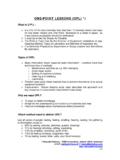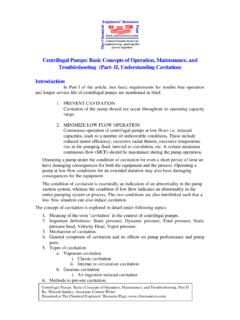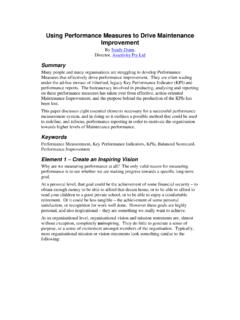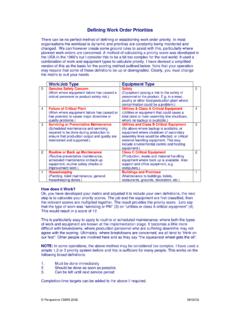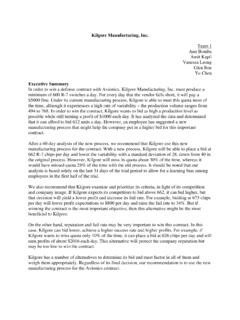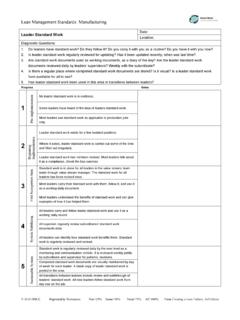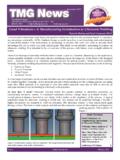Transcription of Lean Maintenance for Lean Manufacturing
1 Lean Maintenance for Lean Manufacturing (Using Six Sigma DMAIC) Before putting new and 30 or 40 year old machines together into Lean Manufacturing lines, do you know how to get the near 100% uptime required? Or, will " Maintenance " become the "tail that wags your dog"? 'Your Achilles heel? A Barrier To Lean To compete in today's global economy and to increase profits, many factories are moving to "Lean Manufacturing ," the next step beyond "Just In Time." Others claim "lean" but hedge on the concept with hidden WIP inventories because they fear what they've seen in the past, when critical path machines go down for a " Maintenance break." Other managers simply budget for and bolster their Maintenance department with people, training, equipment and spare parts so they can more quickly "put out the fires" when downtime occurs.
2 Others increase budget (expense) to hand off Maintenance responsibility to outside subcontractors. Outside service vendors may or may not service you better, but its sure nice to be able to point the finger outside when downtime cripples production. But, its still your downtime. The Maintenance Problem The underlying problem here is equipment reliability and uptime (some call it Maintenance reliability). The solution is to find ways to eliminate unscheduled equipment downtime. The problem with downtime is that most Maintenance people think, "It just happens. Then we fix it." The problem with downtime is, "You can monitor it, measure it, log it, report it, track it, attack it, or delegate it, but downtime will not go away until you "eliminate it" - prevent it from happening in the first place.
3 A Solution (Lean Maintenance ) What? How does one "fix a machine so it doesn't break down again"? Answer: To prevent downtime from happening before it occurs, you must eliminate the basic stresses that cause the downtime. What is needed is a methodology for protecting computers, automation controllers, PLCs, CNC machines, etc. and protect their electronic and hydraulic control systems from the stresses that cause malfunctions and failures. The author has been applying this methodology and perfecting it since 1977. He calls it "Lean Maintenance for Lean Manufacturing ." This practical and most cost effective methodology can help most any facility from data centers to telecom to medical, from semi-conductor Manufacturing to plastics & metal Manufacturing .
4 Within 30 - 60 days, you can thus avoid malfunctions, failures, unscheduled downtime, scrap parts, re-work, missing delivery schedules, etc. and get the near 100% reliability, repeatability, yield, and uptime needed to increase profits. Improved uptime is also needed as companies push to lower costs by shedding: 1. Onsite spare parts 2. Onsite board or component repair, and 3. Onsite technicians, Maintenance engineers, etc. The few skilled technicians are getting old. In 3 - 7 years most of this rare breed will be retiring and replacements are not present in training. "Lean Maintenance " can help by providing methods that allows reduced Maintenance support and reduced Maintenance overhead (often 50% or better) while achieving maximum permanent reduction of unscheduled downtime, typically; 50% reduced mechanical downtime 80% reduced hydraulic systems downtime 92% reduced electronic systems downtime Cost of Downtime So what is the cost of downtime?
5 Is it something worth eliminating? Different companies calculate or toss different figures; typically $500 per hour for a stand-alone machine, $1,500 - $8,500 per hour for a cell or line of machines, and up to $3,500 per minute ($181,500 per hour) for an entire auto factory line. One practical way to give your "cost of downtime" figures a reality check is to compare them to the price you would pay, or do pay, when you have to "farm out" a part or assembly because your capacity is temporarily or permanently limited. What do they charge you per hour for this capacity? That's the cost of your downtime. Believe it. Any profit margin they have calculated in is quickly offset by your own continued need to pay support and regular production personnel who often stand idle.
6 Add to this your scrap and rework costs and you see the true hourly cost of downtime. (Manually add your costs as calculated here.) Cost of Scrapped Parts $ + Other Error Costs $ + Cost of Hourly Downtime $ x Hours of Downtime Hours TOTAL COST OF DOWNTIME$ Cost of Scraped Parts + Error Cost + Hourly Cost of DT x DT Hrs. = $ Only after you have a firm grasp on your cost of downtime can you then calculate the importance and impact Lean Maintenance methods can provide by way of increased profits, decreased cost of goods sold and the impact this can have on increased market share. In Lean Manufacturing the cost of a single machine going down for Maintenance is multiplied by the number of machines in that cell. With no parts in inventory, a single machine going down results in no parts shipped.
7 Broken delivery schedules that cannot be made up, if the next parts made are "just-in-time." It's not only lost sales, its reduced level of integrity and less satisfied customers which can result in long term loss of sales revenue. Downtime then results in a higher cost-of-goods sold which means reduced ability to expand or maintain sales and business volume. Lean Maintenance - Methodology The key objective of Lean Maintenance is to give your company the near 100% equipment uptime and reliability it demands while cutting your Maintenance expense, often by 50% or more. This is done by systematically surveying or analyzing each machine and control system to determine which basic stresses are effecting each machine, over time, and laying out a scheme to protect each machine, computer, or control system from the stresses to which it is subject.
8 This certainly includes but goes far beyond the normal oil change, filter change PM procedures given in the Maintenance manual. You must first understand the three categories of downtime: 1. Downtime from Operator or Programmer Error 2. Downtime from inadequate PM procedure or performance 3. Downtime from chronic wear & stress to circuit boards, hydraulic components and other system components. Stresses such as: a. Heat b. Vibration c. Oxidation & Corrosion d. Dirt build-up e. Electrical voltage transients and current surges f. Hydraulic contaminations of dirt, water & acids, etc. Six-Sigma, ISO-9000 and TPM books and strategies often cover the first two issues (above), yet they often get passed over. "Lean Maintenance " stresses the importance of all three (above) and focuses on the third.
9 "It's like preventing fire hazard," You can have fuel stored or flowing anywhere, but do away with oxygen and heat and you cannot have a fire. Similarly if you do away with the chronic stresses that cause ' Maintenance fires,' then you cannot have Maintenance malfunctions, errors, failures, rework, scrap and downtime. The beautiful thing about this method is, for the most part, it's all "one time installation" of protective devices to produce ongoing savings. It in no way changes your current product flow, personnel, procedures, operations, or policies. Yet, you are able to reclaim older or less reliable systems to near 100% uptime." You might call this kaizen for Maintenance reliability, or how to jump from "four sigma to six sigma.
10 " Six Sigma, - Steps to implement Lean Maintenance Define the problem: Unscheduled equipment malfunctions and the resulting rework, scrap parts, downtime and lost production. Why is this a problem? Because now days the machines and computers do all our work. If you don't believe it, just go unplug all your computers and machines for two or three days and see how much product goes out the back door. Watch the 99% decrease in information or services provided. We must realize that the machines and computers are productive employees of the company. The machines are just as much employees as the humans. Each is paid a per hour wage based on their value to the companies products and services. Usually the machine's wages are much higher than human wages.

